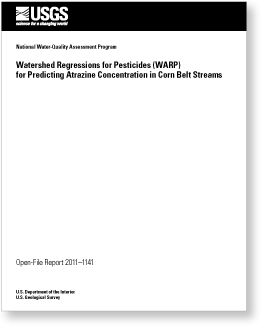Open-File Report 2011–1141

AbstractWatershed Regressions for Pesticides (WARP) models, previously developed for atrazine at the national scale, can be improved for application to the U.S. Corn Belt region by developing region-specific models that include important watershed characteristics that are influential in predicting atrazine concentration statistics within the Corn Belt. WARP models for the Corn Belt (WARP-CB) were developed for predicting annual maximum moving-average (14-, 21-, 30-, 60-, and 90-day durations) and annual 95th-percentile atrazine concentrations in streams of the Corn Belt region. All streams used in development of WARP-CB models drain watersheds with atrazine use intensity greater than 17 kilograms per square kilometer (kg/km2). The WARP-CB models accounted for 53 to 62 percent of the variability in the various concentration statistics among the model-development sites. |
First posted June 2011 Comment For additional information contact: Part or all of this report is presented in Portable Document Format (PDF); the latest version of Adobe Reader or similar software is required to view it. Download the latest version of Adobe Reader, free of charge. |
Stone, W.W., and Gilliom, R.J., 2011, Watershed regressions for pesticides (WARP) for predicting atrazine concentration in Corn Belt streams: U.S. Geological Survey Open-File Report 2011–1141, 18 p.
Abstract
Introduction
Methods
Atrazine Models
Summary and Conclusions
References Cited
Appendixes